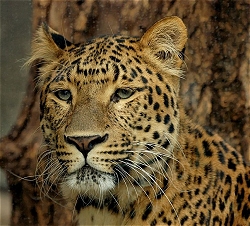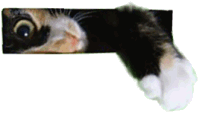Why a leopard can't change its spots and why a Tabby has stripes

Why mammals have coat patterns such as spots or stripes has fascinated researchers for a long time. There are a number of ideas as to why animal coats have a number of different patterns. Camouflage is an obvious benefit. It seems logical that tigers, which tend to hunt in grasslands have stripy coats, while animals like leopards tend to live and hunt in the woodlands where their spotted coats resemble the dappled shadows of leaves and sunlight. Of course there are exceptions. For example cheetahs can be spotted hunting on the open savanna, though we note that the zebras which roam these same grasslands are striped. (To us the black and white stripes stand out a mile, but not to the more limited colour range of a predator's vision.)
But there may be other reasons for spots and stripes. In zebras each stripe pattern is unique to each individual animal and it may be that zebras use these distinctive patterns to identify other members of the herd. While zebras have famously dramatic coat markings, the cat family are world beaters for their diversity of spots, stripes clouds and blotches; but until recently the genetic science behind animal coat patterns was completely unknown. But a recent study published in Genetics (2010; 184 (1): 267 )1 has taken the first steps towards understanding the genes behind the spots.
The researchers cross-bred domestic cats with different coat patterns, such as stripes and blotches, and watched to see what patterns appeared in the offspring. Genetic samples were collected and used to identify molecular markers. The results showed that every time a given coat pattern appeared, the kitten with that coat pattern had inherited specific markers. This suggests that the marker and the gene causing the coat pattern are in the same region of the feline genome.
The researchers focused on four pattern variants of Tabby: an unpatterned agouti form called 'ticked' (Ta); 'spotted' (Ts); 'mackerel' (i.e. striped)(TM) and blotched(tb). Scientists were then able to pinpoint the location of the genes involved these distinctive coat patterns. It turns out that that at least three different areas of the genome control the markings of the domestic cats. The 'Ticked' locus was on cat chromosome B1. A different area controls the stripes (TM), and blotches (tb) which are on the feline A1 chromosome. Researchers are still hunting another part of the gene sequence which they believe gives a cat a spotted coat by altering the mackerel stripes.
But knowing if a kitten will have stripes or spots is one thing, understanding the actual pattern of stripes and spots is another. To observe this we turn from kittens to that paragon of stripiness, the zebra. The three species of zebra: common zebra (E. burchelli), imperial zebra (Equus grevyi) and the mountain zebra (E. zebra) all have the traditional stripes but the number of stripes in each species is very different. The common zebra has 26 wide caudal stripes per side, the mountain zebra has some 43 stripes but the imperial zebra has as many as 80 stripes per side.
In the model which explains the different numbers of stripes it all comes down to how soon the stripes form on an unborn zebra. Zebra stripes appear between weeks three and five, depending upon the species. All the stripes are the same width apart. The stripes of a common zebra appear the earliest (within three weeks of gestation) when the embryo is about 11 mm long. Assuming that the pattern for each species is the same, the mountain zebra embryo would have to be larger to fit more stripes. And this appears to be what happens. Because the stripes appear at a fixed interval on the coat, you can only get a certain number of stripes on a zebra. The older the fetus, the bigger it is, and the more stripes you can fit on it. So the number of stripes on different species of zebra seems to depend on when they start to appear on the unborn foal.
Now it remains to be seen whether the same genetic code is true of the felis family, and whether breeders will be able to use this information to create spectacular new breeds in the future. You read it here first!
1. Eizirik et al. Defining and Mapping Mammalian Coat Pattern Genes: Multiple Genomic Regions Implicated in Domestic Cat Stripes and Spots. Genetics, 2010; 184 (1): 267

